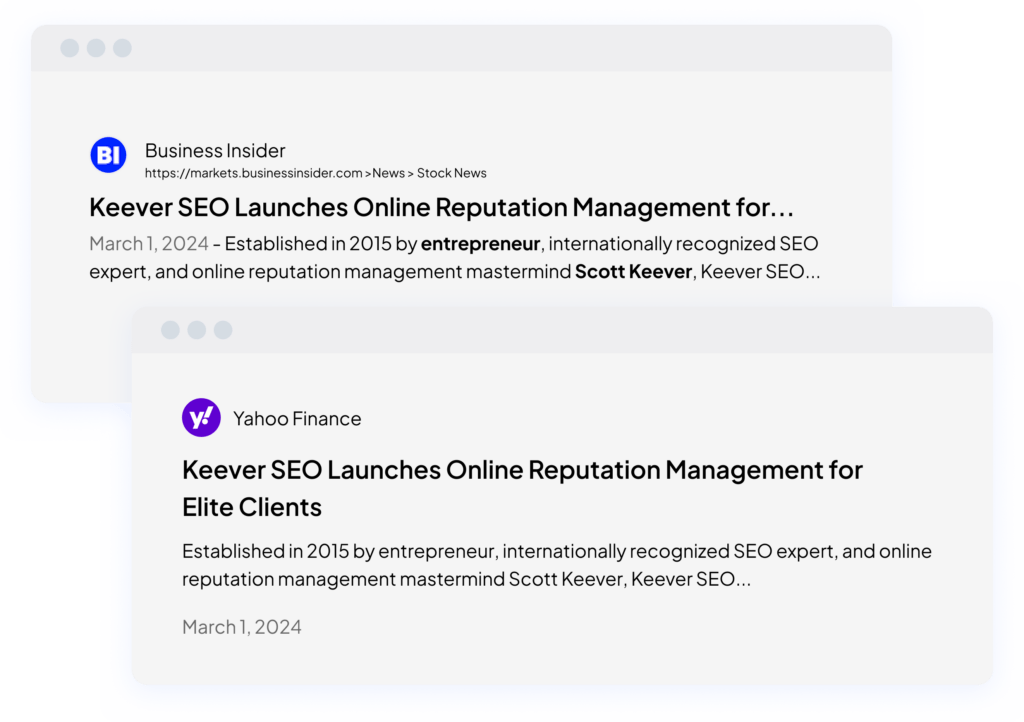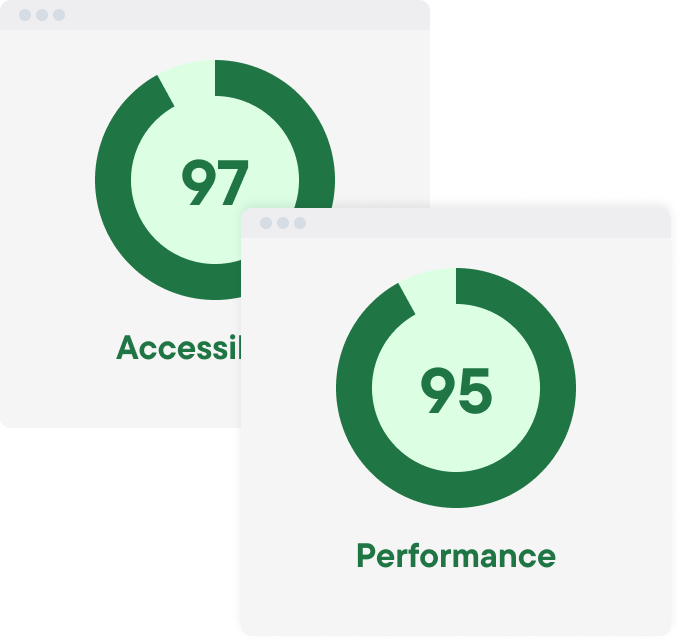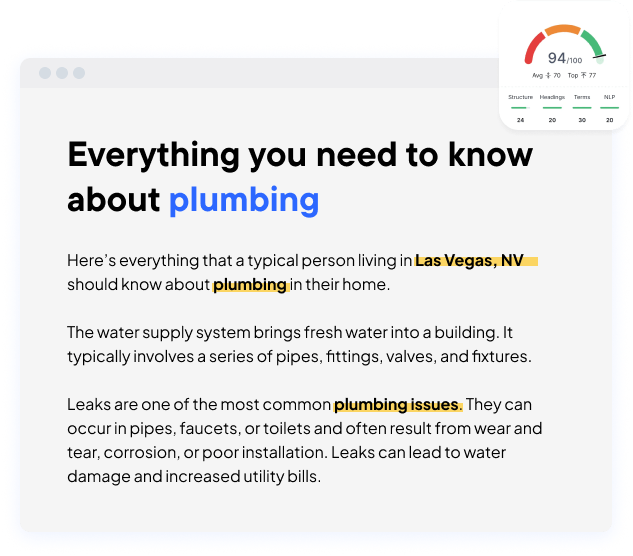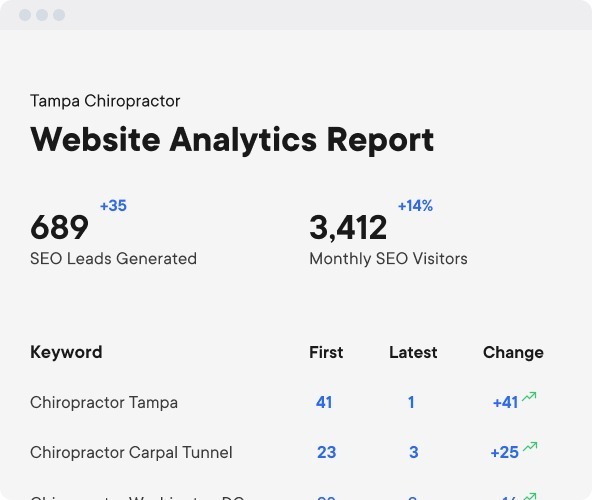Get More Clicks, Leads, and Customers through Search Engine Optimization
- Grow your online presence
- Maximize content marketing
- Show up in Search Engine Results
How we Drive Business
For Our Clients
We help local brands appear in search results for target search phrases
- Increased Google Maps from position 18 to 3
- Went from 0 monthly leads, to a steady monthly flow
- 240% more calls within 5 months


We help international brands appear in search results for target search phrases
- Ranked on page 1 for their most impactful search terms
- 427% increase in targeted traffic
- 32% revenue increase YOY

We help national brands appear in search results for target search phrases
- 100+ new keywords ranking on age 1
- 216% increase in targeted traffic
- Boosted online presence in their top 5 lucrative cities
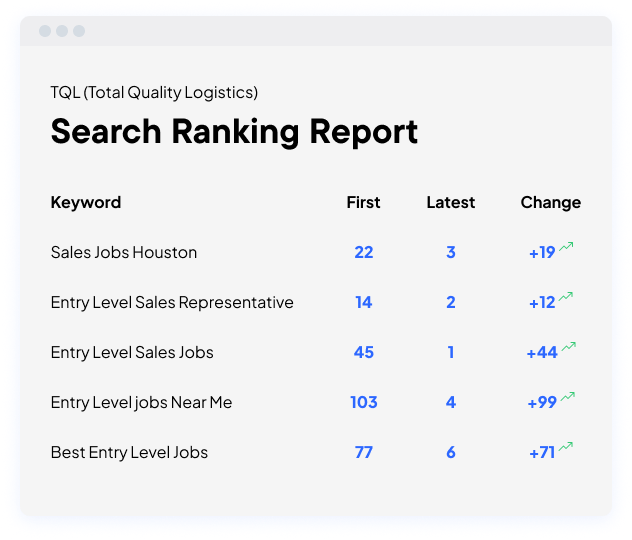
Your First 30 Days With Keever SEO
Your First 30 Days With Keever SEO
Benchmarks
Document any current keyword rankings, so we can set the bar and measure improvement.
Keyword Research
We use competitor and Industry data to find the most effective keywords with buyer intent.
Business Citations
We begin with over 100 business citations from external websites to yours.This ensures consistency across multiple directories and helps Google provide accurate information about your brand.
100-Point SEO Audit
We begin with over 100 business citations from external websites to yours. This quickly gets the ball rolling on domain authority.
Backlink Campaign
We’ll outreach to high quality, reputable websites and ask them to link back to your website. This quickly gets the ball rolling on domain authority.
What goes into an effective SEO Campaign?
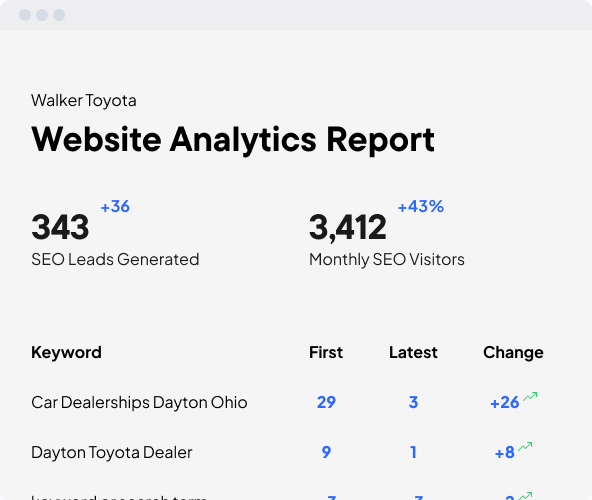
Why Our Clients Love
Working With Us
We drive sales, visibility, and exposure
Transparent, detailed reporting
Average client response time in 5 minutes or less
Why Our Clients Love
Working With Us
We drive sales, visibility, and exposure
Transparent, detailed reporting
Average client response time in 5 minutes or less
- Sustainable, long-lasting growth
- Month-to-month contracts
- Transparency & prioritization
What Is SEO? The Ultimate Guide for Beginners
Understanding SEO
What is SEO: An Overview
SEO's Role in Digital Marketing
Differentiating SEO, SEM, and PPC
Historical Evolution of SEO
Major Google Algorithm Updates
Google Florida Update (2003)
Google Panda Update (2011)
Google Hummingbird Update (2013)
Google Penguin Update (2012)
Mobilegeddon (2015)
- Text size and readability on mobile screens.
- The accessibility of links and buttons for touch screens.
- Responsive design that adjusts to various screen sizes.
Google RankBrain (2015)
Google Medic Update (2018)
- Does the content provide a more comprehensive or accurate answer to the user’s query than competing articles?
- Does the article include more recent data and current statistics than others, offering the most up-to-date information?
- Are there supportive elements such as pictures and videos that enhance the content and make it more engaging and informative for the reader?
Google BERT Update (2019)
Core Web Vitals Update (2021)
Helpful Content Update (2023)
The Value of SEO
Exploring the Benefits of SEO
- Cost-Effective Visibility in Organic Search: SEO is a cost-effective way to enhance your visibility through organic search. It complements paid marketing strategies effectively, providing a balanced approach to search marketing.
- Credibility and Trust: SEO does not just increase the visibility of your page; it also builds credibility, trust, and brand recognition. You connect better with your customers or audience by ranking higher in search engines like Google, as they know you to be more of an authority in your chosen niche.
- Long-Term Strategy with Lasting Effects: Once you have invested in SEO, the benefits continue even after you stop actively investing. It is a long-term strategy that offers lasting effects, making it a sustainable marketing approach.
- Quantifiable Results: SEO results are quantifiable and more manageable, allowing you to better measure and track the effectiveness of your website's optimization strategies over time.
- Comprehensive Marketing Approach: Integrating organic and paid strategies is essential to make the most out of search marketing and reach a wider audience. SEO plays a crucial role in this comprehensive approach.
The Impact of SEO on Web Visibility
Unraveling Search Engine Mechanics
Grasping Search Engine Algorithms
Process of Website Indexing
Role of Crawlers in Search Engines
SEO Functioning Explained
Relevance: A Key in SEO
- Navigational: "Facebook"
- Informational: "Facebook privacy settings"
- Commercial: "Facebook marketing tools"
- Transactional: "Download Facebook app"
- Topical Relevance: Ensuring the content is directly related to the user's interest in Facebook, whether it is about using the platform, its features, or its corporate information.
- Content Freshness: Maintaining up-to-date information is particularly important for a rapidly evolving platform like Facebook.
- Type of Content: Matching the content format (blog post, video, infographic, etc.) to what users looking for information on Facebook are most likely to engage with.
- Location: Tailoring content to the user's location, especially for searches where Facebook's geographical context or local features are vital information.
Crafting Quality SEO Content
Enhancing Usability through SEO
Building Authority with SEO
SEO and User Experience
Classifying SEO Types
- On-Page SEO
- Off-Page SEO
- Technical SEO
On-Page SEO: An Insight
Off-Page SEO: A Closer Look
Technical SEO: The Backbone
Google's SEO Ranking Factors
Decoding E-E-A-T (Experience, Expertise, Authoritativeness, Trustworthiness)
The Power of Quality Backlinks
SEO and Page Speed Optimization
SEO Strategy Implementation
Mastering Keyword Research for SEO
Optimizing Titles and Meta Descriptions
Image Optimization in SEO
Effective Linking Strategies for SEO
Embracing Mobile-Friendly SEO
Mobile Optimization: A Necessity
Implementing Mobile SEO Best Practices
Evaluating SEO Performance
SEO Tools for Performance Tracking
Google Search Console
Google Analytics
Semrush
Ahrefs
Deciphering User Behavior through Analytics
SEO Adjustments Based on User Feedback
Frequently Asked Questions
What Is the Role of SEO in Digital Marketing?
SEO focuses on optimizing your website to rank higher in search engine results, aiming to drive more traffic to your site. This is achieved through various tactics that align with how search engines function and prioritize content.
Visibility is a fundamental aspect of any digital marketing strategy. By increasing a website’s visibility, SEO ensures potential customers easily find a business’s products or services.
SEO intersects with other areas of marketing, such as content marketing and social media marketing. These disciplines work together to enhance a website’s relevance, authority, and user engagement, which are all crucial for effective SEO.
Additionally, SEO complements Pay-Per-Click (PPC) advertising. While PPC focuses on gaining traffic through paid ads, SEO builds on organic traffic, providing a balanced approach to digital marketing.
Can I Do SEO Myself?
Yes, it is entirely possible to do SEO on your own. Many individuals and businesses successfully manage their SEO strategies without external help.
Remember, all professionals or agencies prominent in the SEO industry began independently learning and implementing SEO strategies. This hands-on experience was invaluable in understanding the nuances of SEO.
You only need a willingness to learn and a platform to apply your newfound SEO knowledge. This could be a personal blog, a business website, or a social media account.
These platforms provide a practical environment to experiment with and improve your SEO skills.
Furthermore, numerous tools and resources are available online, including instructional videos and guides to help you get to where you want to go.
These resources can help you acquire new skills and strategies to optimize your online content and extend your reach to a broader audience.
How Do I Start Learning SEO?
The first step in learning SEO is to engage in extensive research. This is a crucial part of the learning process. Do not hesitate to delve deeply into the subject, especially the technical aspects, as you familiarize yourself with the basic concepts.
Guides and articles like this offer valuable tips and strategies that can help you grasp the fundamental principles of SEO. These resources are an excellent starting point for beginners.
Once you have a solid understanding, create your SEO process and strategy based on what you have learned.
Focus on optimizing and producing high-quality content that can be shared online. This practical application of knowledge is critical to mastering SEO, as it will help you learn what works for you and your site.
Build your credibility in the digital space through backlinks, and ensure your content is optimized for search engines and provides real value to your audience. This balance is critical for long-term success in SEO.
Finally, never stop learning. SEO is a dynamic field, with constant updates and changes as technology and the internet evolve. Staying informed and adapting to these changes is essential to maintain and improve your SEO skills.
Do I Need an SEO Tool?
SEO often relies on precise data and analysis to be effective. Accurate keyword information, search trends, and website performance are critical to developing a successful SEO strategy.
While conducting a significant amount of SEO work without specialized tools is feasible, having access to them can significantly enhance your efforts.
Utilizing SEO tools can offer additional insights, save time, and increase efficiency in creating high-quality content. These tools often provide detailed data and analytics that are not readily available.
In the long run, the benefits and insights gained from these tools can far outweigh the initial cost, making them valuable assets for your online marketing strategy.
Many free tools are available online to help you create content that can also rank in the search results.
How Does SEO Help in Driving Traffic to My Website?
SEO focuses on optimizing your website for relevant keywords and phrases. As a result, your content is more likely to appear in search engine results when people search for those specific terms.
SEO is one of the common ways of how to increase website traffic with positive long-term effects on your site.
This increased visibility in search results drives more traffic to your website. It also enhances the likelihood of converting your audience into leads or customers as they find your site through relevant searches.
How Does SEO Help in Driving Traffic to My Website?
Conclusion
SEO stands as a cornerstone, essential for enhancing online visibility and engaging effectively with target audiences. Its importance lies in its ability to adapt and evolve with the ever-changing search engine algorithms and user behaviors.
Continuous learning and adapting SEO strategies are crucial to staying ahead in this competitive field, ensuring that digital marketing efforts are practical and relevant and converting clicks to cash on your website.


